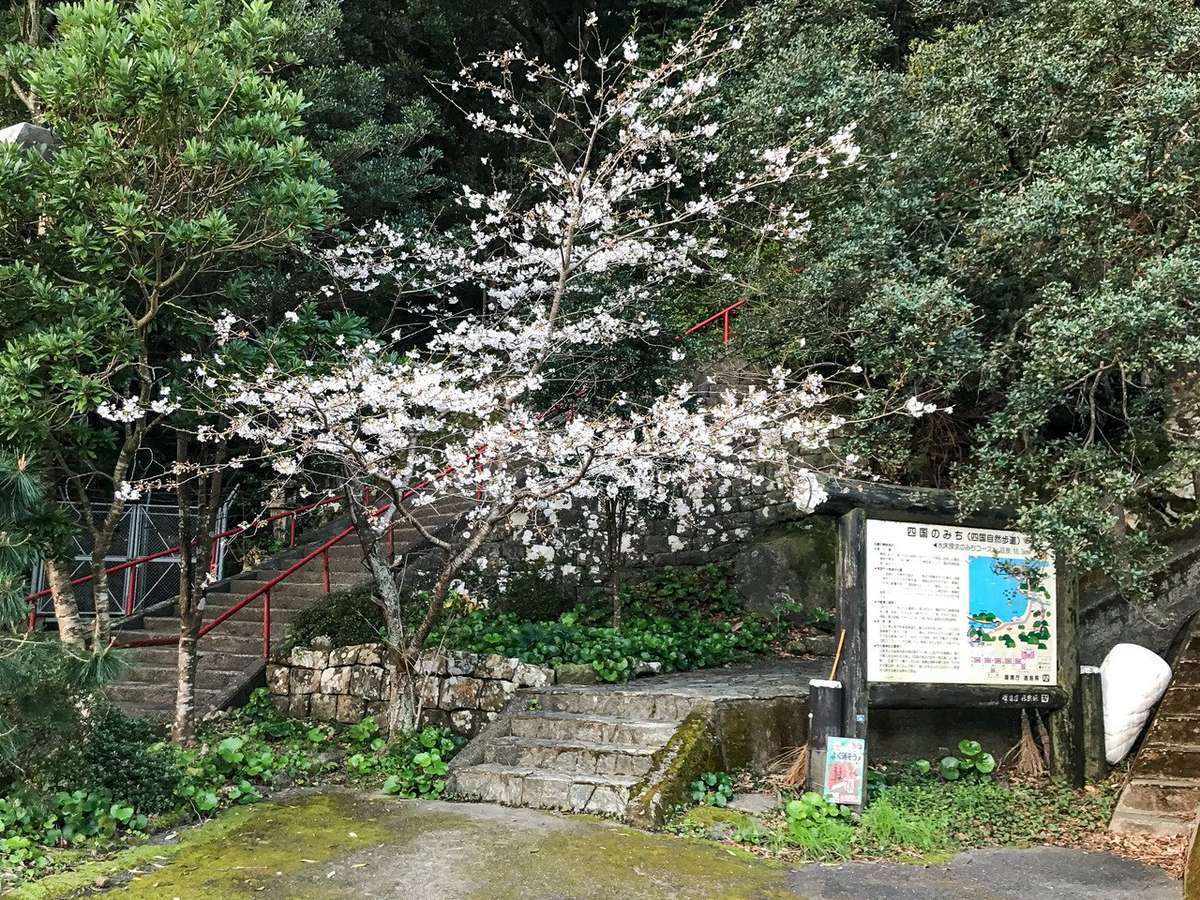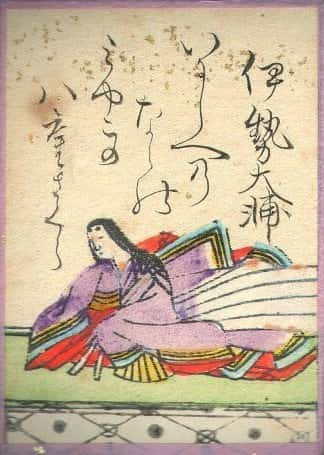目次
The origin of the word “sakura”.

Shikoku Road Takegashima Cherry BlossomsWhenever spring arrives in Japan, it always brings the sakura (cherry blossoms) with it. Sakura are a symbol of Japan and cherry blossom viewing parties are usually held throughout the country starting in late March into early April. Everyone has probably seen sakura petals dancing in the air at least once and have heard songs written in the lyrics of many Japanese songs. Although cherry trees are so commonplace in Japan, most Japanese have probably never heard about the origin of the word.
Many linguists support the theory that the suffix ら(ra) was added to the verb “咲く” (to bloom) to form さくら (sakura), which came to mean “blooming like a beautiful flower”. Another theory is that the word sakura stemmed from the word (作労) “sakuro”, which means “to labor”. It has also been said that the word “sakura” is a transposition of similar characters referenced in various Japanese literature such as Princess Sakuya (サクヤ姫), Sakihaya (咲光映), and Sakuru (裂), and according to Japanese folklore, sakura is referenced came from the god of rice, Sa, who comes to visit and is enshrined into the altar (kura) during springtime.
In any case, the kanji character for sakura [桜] was first used in the eighth century compilation of the book NIHONSHIKI and came to be associated with the emperor’s feasts. Today, the word is generally used to refer to the deciduous cherry blossom tree that is a part of the rose family.
The word sakura also has a second meaning: “to disguise”. In this context, a sakura is a person or a group who pretends to be a customer at a street stall to deceive customers into buying cheap items at a much higher price. They can also pretend to be an audience member by clapping their hands and cheering to help liven up the audience for the performer on stage. However, how and why this meaning of sakura came to be is still unknown.
Sakura petals and “Yaezakura” (eight-layered cherry blossoms)

YaezakuraSakura blossoms exemplify the beauty of the blooming sakura trees. The word “yae” (eight-layered) is used to describe a cherry tree with high-volume blooms that open up beautifully to welcome in the next spring season. In other words, the many cherry blossom petals that cover the tree look as if there are eight overlapping petals. Because the tree produces beautiful blossoms with eight even layers of petals, the word “yae” somehow combined with “sakura” to create the newer word, “yaezakura”.
Cherry blossoms commonly only have five petals. Some sakura trees have more than six petals, and some have dozens of petals. However, sakura trees with six or more petals are called “yaezakura”. There are sakura trees with even more than 100 petals that are also called yaezakura. Eventually, any sakura blossoms with countless petals have come to be known as yaezakura.
The historical background of “yaezakura”
Some dictionaries state that the word yaezakura is a variant of “yamazakura” as it was first found in a poem fromthe MANYOSHU ANTHOLOGY. There is also a theory that “yaezakura” is an abbreviation of “yaezaku sakura” and when “yaezakura” was actually first used is unknown. However, in the late 12th century, Fujiwara no Teika used “yae saku” and “yae sakura” in his poems that can be found from his SHINKOKIN WAKASHU (New Collection of Ancient and Modern Japanese Poetry).The oldest example of the use of this “yaezakura” can be found in Fujiwara no Teika’s “Iroha poem”.
Yaezakura also means that the overlapping beautiful petals cover the view of the scenery so much that even the background is hidden. This is because cherry blossoms bloom once a year at the start of the season, but the petals fall off within a few weeks after they are blown away by the wind. Therefore, the word yaezakura also contains a secondary meaning of “being hidden” and “vanished away”.
Why eight petals and not seven or nine?

The most common type of cherry blossoms have five petals, but anything more than five are called “yaezakura”. So then, why are cherry blossoms called “yaezakura” no matter how many petals they may have? Since cherry blossoms can fill an entire landscape as if it were snow, perhaps, they were grouped together under the first word “yae” to describe the overlapping petals. Furthermore, why is “yaezaki” (eight) used but we don’t use “nanaezaki” ( seven-petaled) or “kokonoezaki” (nine-petaled) cherry blossoms? There must be a reason as to why the word “yae” has become a general term for six or more petal blossoms.
One theory assumes that the kanji character for the number 8 (八) was used to express the fact that the petals disperse to the “ends of the eight directions,” as was written in the Chinese history book the HISTORY OF THE LATER HAN. However, the theory does not explain how the pronunciation changed to yae. The most logical interpretation of the etymology for the Chinese characters 八重 “yae” (eight-layered) reading came from the God of Israel “Yahweh,” in the Old Testament.
Yae was read as “Yaa-heh” in Archaic Japanese

Daisuke Ise singing ‘Yaezakura
of Ancient Nara capital’The reason why the word “yae” is thought to originate from the Hebrew word “Yahweh,” meaning “God,” is in the pronunciation of (yae) “八重” or “ヤエ” (yae) itself. “Yae” was originally pronounced as “yah-heh” in archaic Japanese. A vine-like plant is described in the TALE OF GENJI that grows in several clusters wase written as やへーむぐら”yaheh-mugura” or 八重葎 “eight-layered creepers”. It is clear that the original reading of “八重” yae was not “ヤエ” yae, but it was ヤーへ “yaa-heh” or ヤヘー “ya-heh”.
Yae (八重) in archaic Japanese,closely resembles Yahweh in Hebrew if it were read as the correct reading “yaa–heh”. The word comes as close as possible to the Hebrew word for “God” consisting only of consonants,יהוה(yhwh), with the addition of any vowel sound. In the northwestern part of Iheya Island close to the main island of Okinawa, there is a rock formation called Ya-heh Rock. The rock may have been called Yaheh because it was sacred.
Can Sakura be considered a Hebrew word, too?
If the first word “yae” in yaezakura is derived from the Hebrew word for God “Yahweh”, then “sakura” should also be understood in Hebrew. The Hebrew spelling for sakura is שקר(sheker, shekerah). The word menas to “to hide” or “to deceive”. Shekerah sounds almost identical to sakura in Japanese and they both share the same meaning. To show an example, a person who is either hired or asked by a merchant to induce others to buy things is called a sakura.Perhaps, the origin of the word was in Hebrew, shekerah, that meant hiding one’s background and to be in disguise.
Since yae and sakura can be read in Hebrew, and yae means God, the words seem to be related to something important about godly matters. Assuming that the origin of yaezakura actually comes from “yahe shekerah” in Hebrew, the true and original meaning of the Japanese word sakura rises to the surface.

In Japanese, combining “yae” and “sakura ” into “yaezakura” was long thought to have meant that cherry blossom petals completely covered the view outside in a blizzard of petals. However, the etymology of “yaezakura” is connected to “yaaheh-shekerah” in Hebrew and reveals another meaning, “divinely hidden” or “God disappears and is hidden”. The melody in the traditional Japanese folk song skillfully shows the mysterious nature of “Sakura Sakura” in the simple musical motif.
Contrary to what Japanese may think about the traditional song “Sakura Sakura”, a song that all Japanese know by heart, was originally written in Hebrew. From the beginning to the end, the lyrics can be understood in Hebrew, and furthermore, the melody has an underlying “divinely hidden” meaning. By unearthing the hidden meaning through Hebrew etymology of yaezakura, we can find the “divinely hidden” within the song “Sakura Sakura” and the intent of the writer.
